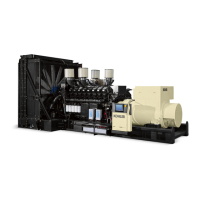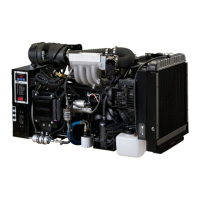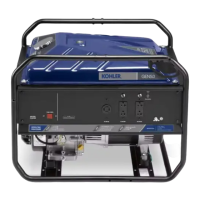TP-7070 7/1892 Section 3 Scheduled Maintenance
b. To check the fan belt tension using belt
deflection, use the following procedure:
(1) Measure the belt span (center line of pulley
#1 to center line of pulley #2).
(2) Use the measurement to determine the
middle of the belt.
(3) Press on the V--Belt at the middle point and
measure the deflection from its original
position.
(4) For the maximum deflection, refer to
Figure 3-19.
Engine to Fan Sheave (Driver to Driver)
KD2000 to KD2500
Frequency (Hz) Deflection
New Belt 78.4--81.2 81--86 N @ 9 mm
(18--19 lbs @ 0.4 in.)
Used
Belt
72.6--75.6 70--75 N @ 9 mm
(16--17 lbs. @ 0.4 in.)
KD2800 to KD3250
Frequency (Hz) Deflection
New Belt 62.7--64.9 89--95 N @ 12 mm
(20--21 lbs @ 0.5 in.)
Used
Belt
58.1–60.5 77--83 N @ 12 mm
(17--19 lbs. @ 0.5 in.)
Note: Tension chart is only applicable for models
KD2000--KD3250.
Figure 3-19 Belt Tension and Deflection
5. Before making adjustments to the tension, loosen
the four 3/4” undercarriage bolts. Then, adjust the
tensioner pulley along the tensioner slots via the
lead screw. See Figure 3-20.
1. Fan pulley
2. 3/4” undercarriage bolt locations
3. Lead screw
4. Tensioner pulley
5. Engine pulley
10301001101
2
3
1
4
5
Figure 3-20 Tension Adjustment, KD2000--KD3250
6. Make the necessary adjustments until belt tension
falls into the range listed in Figure 3-19.
7. Check the pulley alignment on the fan shaft for
angularity.
8. Adjust the fan sheaves and tensioner sheaves to
eliminate or reduce the pulley angularity.
9. Tighten the 3/4” undercarriage bolts.
10. Reinstall the belt guards using the original
hardware.
11. Reconnect the generator set engine starting
battery(ies), negative (--) lead last and return the
generator set to service.
12. Test run the generator set for a few minutes and
listen for belt noise (squeal) indicating a slipping
belt. Stop the generator set.
If the belt slips after the belt tension procedure, clean the
pulley surfaces and repeat the belt tension procedure. If
slippage continues, replace the fan belt.
